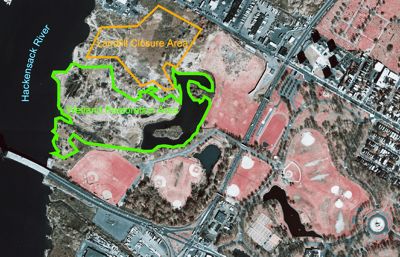| DEP PROVIDES $5 MILLION
FOR LINCOLN PARK RESTORATION
Wetland Renewal and Landfill Closure
Funded with Natural Resource Damage Settlements
(05/126) JERSEY CITY -- Joining Hudson County officials
along the Hackensack River today, Department of Environmental
Protection (DEP) Commissioner Bradley M. Campbell announced a
commitment of $5 million in funding for Lincoln Park to restore
wetlands and redevelop a landfill for active recreation use. Hudson
County also will provide $2 million towards the landfill closure
and redevelopment project.
Hudson County's Lincoln Park site encompasses 270 acres that
includes numerous recreation fields and other facilities. A 31-acre
wetland portion of the site along the Hackensack River will be
restored from a degraded salt marsh that was used as part of a
local landfill to a functioning tidal wetland. An adjacent 20-acre
portion of landfilled area will be properly closed with a cap
and other environmental controls. Landfill operations ceased at
the site in 1982.
"This demonstrates our success in using the "polluter
pays" principle to ensure restoration of urban open space
and habitat," said Commissioner Campbell. "This restoration
along the Hackensack River estuary is key to supporting waterfowl,
shorebirds and native wetland plant species."
The funding comes from three settlements between state and Federal
trustee agencies and companies that caused past water pollution
in the area that resulted in natural resource damages. Trustees
in these cases include DEP, the National Oceanic and Atmospheric
Administration (NOAA), and the U.S. Fish and Wildlife Service.
Trustees will use settlement funds to restore wetlands and endangered
species habitat, increase public access to natural resources,
and protect and manage resources injured by oil spills and hazardous
waste sites.
"In an area with so little green space, this project will
provide over 20 new acres of healthy parkland and ballfields,
providing Hudson County families another option for relaxation
and recreation while also cleaning the environment and providing
valuable wildlife habitat," Congressman Robert Menendez.
"I'm proud for the part I played in getting this project
started, and I'm extremely pleased that the state and county are
now taking the next steps in cleaning this local treasure."
"NOAA is excited to join our state and local partners to
restore this degraded wetland ecosystem in Lincoln Park,"
said retired Navy Vice Adm. Conrad C. Lautenbacher, Ph.D., under
secretary of commerce for oceans and atmosphere and NOAA administrator.
"This project will benefit New Jersey citizens, the fish
and wildlife resources in the Hackensack River, and the greater
New York/New Jersey Harbor ecosystem."
Lincoln Park is the jewel of our outstanding county park system,"
said Hudson County Executive Thomas A. DeGise. "We are pleased
that our $2 million commitment to expanding and improving Lincoln
Park has been matched - and exceeded by the State with these polluter
settlement dollars. It is a sensible, cooperative approach to
a regional concern that environmentalists, recreation advocates
and tax payers can support in equal measure."
"A little innovation and lots of cooperation by Hudson County
Parks, NJDEP and partners have produced a great example of what
a brownfields-to-greenfields urban restoration can be," said
Greg Remaud, preservation director, NY/NJ Baykeeper. "A heavily
impacted site will be cleaned, natural habitat will be improved,
and recreational opportunities for residents will be expanded."
Trustees and the U.S. Army Corps of Engineers evaluated various
restoration alternatives for the Lincoln Park site. The wetland
restoration plan will include removal of landfill debris, creation
of tidal channels, and planting of salt marsh vegetation. In addition,
the adjacent landfill area will be capped using the excavated
material from the site. This process will lower the site elevation
of the 31-acre area so that it can once again be regularly flowed
by the tide and support native wetland plant species with high
habitat value.
The on-site landfill consolidation and closure component includes
placement of a soil cap with storm water management controls.
Active recreation plans will be incorporated into the cap design
to allow for safe use of the area by residents. DEP will continue
to partner with Hudson County and the National Oceanic and Atmospheric
Administration (NOAA) to oversee the construction work.
The funding sources for the design and construction work include
settlements for the Cynthia M sodium Hydroxide spill in the Hackensack
River in 1994 initiated by NY/NJ Baykeeper, the Exxon Bayway petroleum
spill in the Arthur Kill in 1990 and ground water contamination
from the Hudson County chromium sites.
Background on DEP Natural Resource Damage Program
Natural Resource Damage claims compensate the residents of New
Jersey for the injury and lost use of natural resources due to
contamination. Injuries can refer to both ecological injuries
to wetlands, wildlife, ground water or surface water and to human
use injuries such as the closure of a waterway to fishing, a beach
to swimming or an aquifer for use as drinking water supply.
DEP's preferred voluntary settlement track has resulted in the
settlement of natural resource damages at 371 hazardous sites.
The total preserved wildlife habitat and aquifer recharge area
is more than 4,000 acres.
In addition to protecting more than 4,000 acres of wildlife habitat
and aquifer recharge area, DEP and the Attorney General's Office
have recovered approximately $30 million since 2002. DEP also
is working with 95 additional responsible parties representing
about 850 sites that seek to voluntarily resolve their liability
for natural resource damages.
NRD claims are separate from the costs associated with cleaning
up contamination. New Jersey's Spill Compensation and Control
Act makes any entity that has discharged hazardous substances
onto the land or into the waters of the state liable for both
cleanup and for natural resource injuries.

View a larger version of the aerial
image (70 Kb)
PDF of the larger image
(1.16 Mb; requires a free
reader)
|